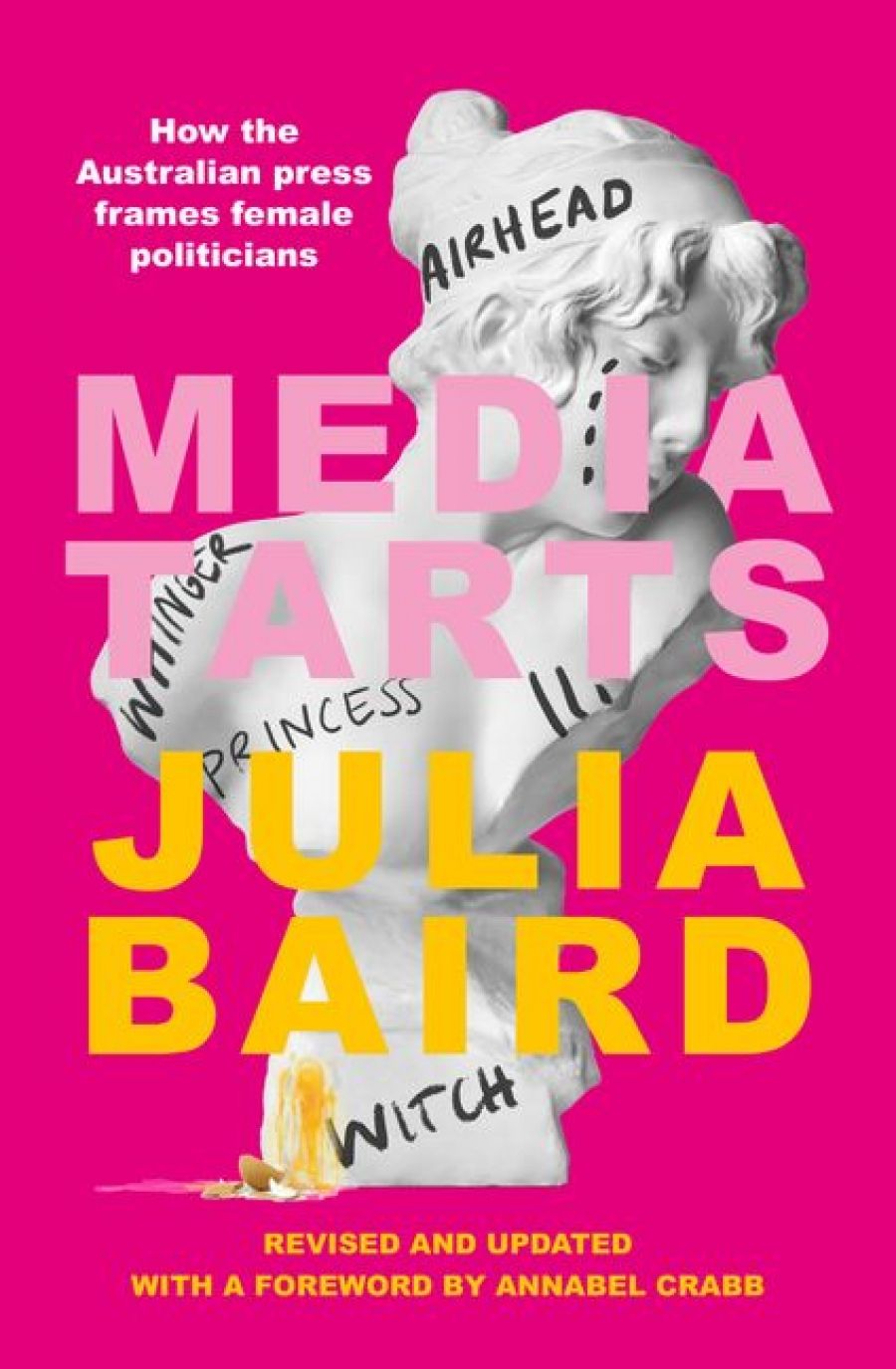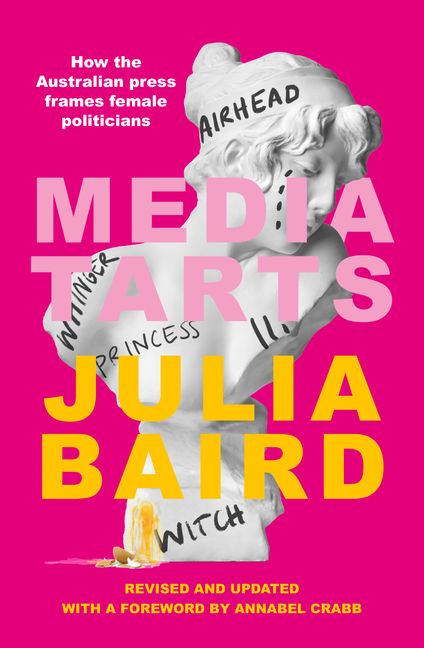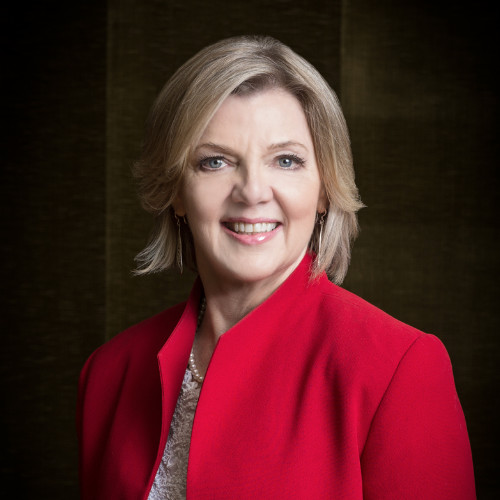
- Free Article: No
- Contents Category: Politics
- Review Article: Yes
- Article Title: Peaches and Cream
- Online Only: No
- Custom Highlight Text:
Bring back Carmen. Bring back Cheryl. Bring back Natasha. I would even have accepted a bit of Bronwyn as a relief from the relentless maleness of this year’s federal election campaign. The female politicians who were household names less than a decade ago – Carmen Lawrence, Cheryl Kemot, Natasha Stott Despoja, Bronwyn Bishop and Pauline Hanson – have been disgraced, marginalised or relegated to the backbenches. Replacements do not appear to be imminent, in part because the still-pitiful number of female parliamentarians are rarely allowed to shine. In the campaign, for instance, talented female politicians such as Julia Gillard were kept tucked away, despite the fact that what might be called women’s issues – especially childbearing and rearing – were central to the platforms of both major parties.
- Book 1 Title: Media Tarts
- Book 1 Subtitle: How the Australian press frames females politicians
- Book 1 Biblio: Scribe, $32.95 pb, 330 pp
- Book 1 Cover Small (400 x 600):

- Book 1 Cover (800 x 1200):

- Book 2 Title: Chika
- Book 2 Subtitle: The autobiography of Kerry Chikarovski
- Book 2 Biblio: Lothian, $35.95 pb, 237 pp
- Book 2 Cover Small (400 x 600):

- Book 2 Cover (800 x 1200):

Meanwhile, for the two leaders, John Howard and Mark Latham, the personal became political, as feminists used to say. This pair of suited battlers worked hard to display their credentials as suburban family men, a competition in which the Labor leader had the advantage because his children are still young enough to require constant care. Before an audience of journalists, Latham played kick-to-kick with his sons in their suburban backyard; he spoke often about how much pleasure he derived from reading bedtime stories to the wee fellows. That is delightful, but you can’t eat words, and I must say I wondered who cooked the meals, calmed the tantrums, washed the clothes, wiped the bottoms, made the beds and did all the rest of it for the remaining twenty-three hours of the day.
My curiosity did not appear to be shared. I don’t recall any journalists asking Latham who cared for the children while he was at work. but you can be sure that, had Latham’s wife Janine Lacy been in his shoes, she would constantly be fielding such questions, plus a few supplementaries on clothes, hair, fitness and figure.
As Sydney Morning Herald journalist Julia Baird demonstrates in her feisty and important analysis of how the media describes female politicians, when women enter a house of parliament they are rarely allowed to leave behind their other house the space of their imagined and actual private lives. In 2001, when Stott Despoja was elected leader of the Democrats a radio journalist asked: ‘So Nat, has your partner popped the question yet?’ As Baird tells it, Stott Despoja responded: Just been elected leader of the Australian Democrats; thought we might talk politics.’
As this and dozens of other enraging incidents suggest, the domestic dogs women no matter how high they rise. Baird begins with a discussion of Margaret Thatcher’s first visit to Australia in 1976. The way Thatcher was framed by the media set the trends for future reporting on women in parliament. Each newcomer was scrutinised for signs that she might be a ‘steel sheila Australia’s own “Iron Lady”’. Incredibly, the British conservative leader and former chemist was described as a ‘suburban housewife’, a tag that Thatcher, according to Baird, initially embraced to reassure electors of her non-threatening femininity.
Thatcher’s looks also earned favourable comment: her complexion was ‘peaches and cream’, her hairdo an ‘enormous success’. Overall, she was ‘ooh’ and ‘aah’ attractive. Since then, women with what men deem to be this ‘aah’ factor are sexualised (‘Forget policy, I’ve got great legs,’ read a 1998 Daily Telegraph headline over a photograph of Hanson). Women without it are mocked. Senator Amanda Vanstone, who has been taunted by fellow MPs about her weight, once responded: ‘Better big in the backside than bullshit for brains.’
Reading this, I was reminded of my journalistic apprenticeship in New Zealand in the late 1980s, a time when current Labour Prime Minister Helen Clark’s star was on the rise. Clark was threatening because she was not feminine enough: her hair was too short, her voice too deep and her face seldom made up. She was married but had no children. I seem to remember that her preferred honorific back then was Miss Clark. How things have changed in New Zealand, a nation where voters have had to choose between a leader of the government and a leader of the opposition who have both been women.
Perhaps I am overly pessimistic, but neither Baird’s research nor former New South Wales Liberal leader Kerry Chikarovski’s autobiography gives me much reason to anticipate such a political advance soon in Australia. In different ways, both books reinforce Anne Summers’s depressing assertion in The End of Equality (2003) that women are worse off – politically, economically and socially – now than they were a decade ago.
Baird draws on newspaper archives and the interviews with female politicians and senior men and women in the press gallery that she conducted for her doctoral research at the University of Sydney. She argues that journalist are tougher on women MPs than they are on men, and that this double standard has created impossible moral benchmarks for politicians such as Lawrence, a woman who was canonised then crucified. But Baird also acknowledges that all politicians are ‘media tarts’ and that some women, such Stott Despoja and Kernot were skilled at using their point of difference – their womanhood – to gain media attention. Even so, Baird is shocked at the virulence of attacks on these and other women politicians whose physical attractiveness is too often seen as a sign of lack of intelligence or seriousness.
While the journalists interviewed for Media Tarts remain frustratingly elusive – their private lives just that – Baird s work provides warm personal portraits of female politicians of all political colours. It is a feminist history as well as a study of the media. I especially enjoyed getting to know the quirky Florence Bjelke-Petersen and being reminded of Susan Ryan’s pioneering work in fighting for equal opportunity and sex discrimination legislation.
Media Tarts is an excellent example of how academic work can be translated into an entertaining and topical read – by turns bitchy, outraged, reasoned and proselytising – without losing depth. Recent examples of discrimination such as the furore when Victorian MP Kirsty Marshall breastfed her baby in parliament in 2003, give Media Tarts a welcome immediacy. The book has a tantalising bibliography but no index, which is an annoying omission.
Read as a companion to Media Tarts, Kerry Chikarovski’s autobiography perhaps unwittingly reinforces Baird’s arguments. Chikarovski won the leadership of the NSW Liberals in 1999, three months before a state election in which they were trounced by Labor. Three years later, she was ousted. Her book is introduced by broadcaster Alan Jones, and Chika often mentions her close friend John Howard. Would a man with such powerful connections have suffered a similar fate? Unlikely. In a rare moment of candour in the epilogue. Chika says politics is much tougher for women than for men: ‘I suspect there are not too many male politicians who have to put up with the sort of insult thrown at me once across the Chamber by the Labor Member for Murray Darling, Peter Black, who yelled out, “Go get a face lift.”’
Like Baird, Chikarovski ends her book with a statement of hope that young women will not only continue to be elected but will eventually claim and retain the top jobs. To do this. women will indeed have to be ‘steel sheilas’ for it seems certain that they will be subjected to more attacks by their colleagues and the media.


Comments powered by CComment